Salmon and rice recipe is a culinary classic enjoyed worldwide, offering a delightful blend of flavors and textures. This versatile combination adapts seamlessly to various cuisines and preferences, making it a favorite for home cooks and professional chefs alike. The nutritional benefits of salmon and rice further enhance its appeal, providing a rich source of protein, omega-3 fatty acids, and complex carbohydrates.
This recipe explores the art of preparing this timeless dish, guiding you through different cooking techniques, rice varieties, sauce options, and side dish ideas. From classic grilled salmon with steamed rice to innovative poke bowls, this guide will inspire you to create your own delicious salmon and rice creations.
Introduction
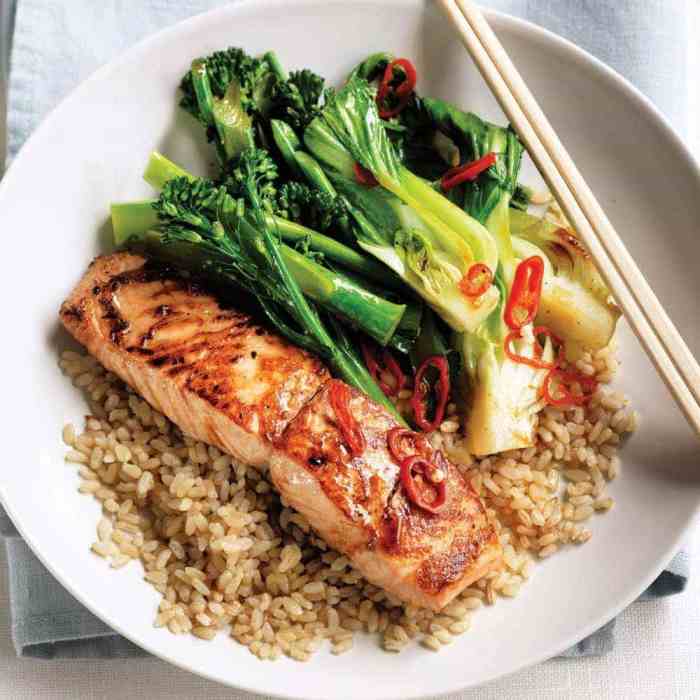
Salmon and rice, a culinary combination that has captivated taste buds worldwide, stands as a testament to the harmonious interplay of flavors and textures. This seemingly simple pairing transcends cultural boundaries, finding its place on dinner tables across the globe.
From the delicate flakes of cooked salmon to the fluffy grains of rice, this dish embodies a versatility that caters to diverse culinary preferences and dietary needs.
Nutritional Benefits
The nutritional profile of salmon and rice makes this dish a wholesome and satisfying choice. Salmon, a rich source of protein and omega-3 fatty acids, plays a vital role in maintaining cardiovascular health and promoting cognitive function. Its high protein content contributes to satiety, making it an ideal meal option for those seeking to manage their weight.
Rice, on the other hand, provides complex carbohydrates, which serve as a sustained source of energy. These carbohydrates are slowly digested, preventing rapid spikes in blood sugar levels and promoting a steady release of energy throughout the day.
Salmon Preparation Techniques
Salmon is a versatile fish that can be cooked in a variety of ways. The cooking method you choose will affect the flavor and texture of the salmon. Here, we’ll explore some of the most popular salmon preparation techniques, highlighting their unique characteristics and tips for success.
Grilling Salmon
Grilling salmon is a popular method for achieving a smoky flavor and crispy skin.
- Preheat the grillto medium-high heat. You can use a gas or charcoal grill. If using a gas grill, preheat the grill for 10-15 minutes. If using a charcoal grill, preheat the grill for 20-30 minutes, until the coals are white-hot.
- Season the salmonwith salt, pepper, and any other desired spices. You can also use a marinade for additional flavor.
- Place the salmon on the grill, skin-side down. Grill for 4-6 minutes per side, or until the salmon is cooked through. You can tell if the salmon is cooked through by using a meat thermometer to check for an internal temperature of 145 degrees Fahrenheit.
- Remove the salmon from the grilland serve immediately.
Baking Salmon
Baking salmon is a simple and easy method for cooking salmon. This method yields a moist and flaky salmon.
- Preheat the ovento 375 degrees Fahrenheit.
- Place the salmon on a baking sheetlined with parchment paper.
- Season the salmonwith salt, pepper, and any other desired spices. You can also use a marinade for additional flavor.
- Bake the salmonfor 12-15 minutes, or until the salmon is cooked through. You can tell if the salmon is cooked through by using a meat thermometer to check for an internal temperature of 145 degrees Fahrenheit.
- Remove the salmon from the ovenand serve immediately.
Pan-Frying Salmon
Pan-frying salmon is a quick and easy method for cooking salmon. This method produces a crispy skin and a tender, juicy interior.
- Heat a skilletover medium-high heat.
- Add oilto the skillet.
- Season the salmonwith salt, pepper, and any other desired spices. You can also use a marinade for additional flavor.
- Place the salmon in the skillet, skin-side down. Cook for 3-4 minutes per side, or until the salmon is cooked through. You can tell if the salmon is cooked through by using a meat thermometer to check for an internal temperature of 145 degrees Fahrenheit.
- Remove the salmon from the skilletand serve immediately.
Poaching Salmon
Poaching salmon is a gentle cooking method that results in a delicate and flavorful salmon.
- Bring a pot of waterto a simmer.
- Add aromaticsto the water, such as onions, carrots, celery, and herbs.
- Season the salmonwith salt, pepper, and any other desired spices. You can also use a marinade for additional flavor.
- Place the salmon in the water, making sure it is completely submerged.
- Poach the salmonfor 8-10 minutes, or until the salmon is cooked through. You can tell if the salmon is cooked through by using a meat thermometer to check for an internal temperature of 145 degrees Fahrenheit.
- Remove the salmon from the waterand serve immediately.
Rice Varieties and Cooking Methods
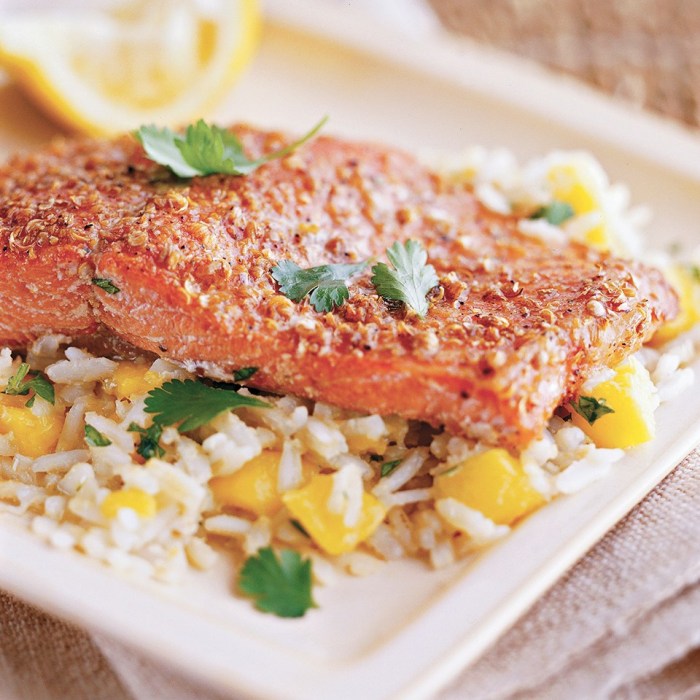
Choosing the right rice for your salmon and rice dish is crucial, as different varieties offer unique textures and flavors that can complement the salmon beautifully. From the fluffy grains of jasmine rice to the chewy texture of sushi rice, the world of rice offers a wide range of options to enhance your culinary creation.
Rice Varieties
Rice varieties play a significant role in the overall taste and texture of your salmon and rice dish. Here’s a table highlighting some popular rice varieties used in salmon and rice recipes, along with their key characteristics:
| Rice Type | Origin | Texture | Flavor Profile | Cooking Time |
|---|---|---|---|---|
| Jasmine Rice | Thailand | Fluffy and slightly sticky | Mildly sweet and floral aroma | 15-20 minutes |
| Basmati Rice | India and Pakistan | Long, slender grains that stay separate | Nutty and slightly floral aroma | 15-20 minutes |
| Sushi Rice | Japan | Short, round grains that are sticky | Mildly sweet and slightly tangy | 15-20 minutes |
| Brown Rice | Various | Chewier and nuttier than white rice | Slightly nutty and earthy flavor | 45-60 minutes |
Rice Cooking Methods
The method you choose to cook your rice can significantly impact its texture and taste. Here’s a breakdown of common rice cooking methods and their suitability for different rice types:
Stovetop Method
The stovetop method is a classic and versatile approach to cooking rice. It allows for precise control over the cooking process, making it suitable for various rice types.
To cook rice on the stovetop, simply combine rice and water in a saucepan, bring to a boil, then reduce heat and simmer until the water is absorbed.
Rice Cooker Method
Rice cookers are a convenient and efficient option for cooking rice, especially for busy individuals. They automatically adjust the cooking time and temperature, ensuring perfectly cooked rice every time.
You also will receive the benefits of visiting green tea shot recipe today.
Rice cookers are particularly well-suited for sticky rice varieties like sushi rice, as they can achieve the desired level of stickiness without overcooking.
Pressure Cooker Method
Pressure cookers offer a faster and more efficient way to cook rice. They use steam pressure to cook rice quickly, resulting in tender and flavorful grains.
Pressure cookers are ideal for cooking brown rice, as they can shorten the cooking time significantly while preserving its nutritional value.
Sauce and Flavor Profiles
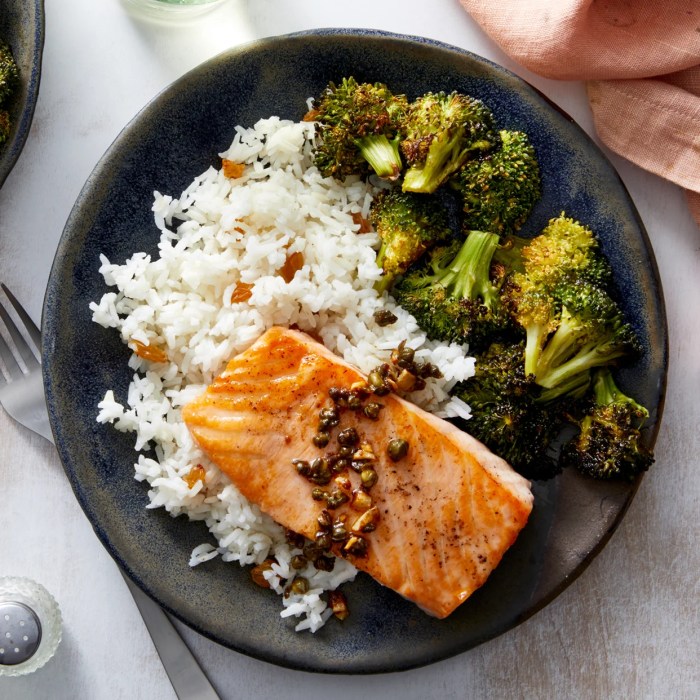
The right sauce can elevate your salmon and rice dish from ordinary to extraordinary. There are countless options, each offering a unique flavor profile that complements the delicate taste of salmon and the versatility of rice.
Sauce Variety and Flavor Profiles
The following table highlights some popular sauce choices, their key ingredients, flavor characteristics, and recommended salmon and rice pairings.
| Sauce | Key Ingredients | Flavor Profile | Recommended Salmon & Rice Pairing |
|---|---|---|---|
| Teriyaki | Soy sauce, mirin, sugar | Sweet, savory, umami | Grilled salmon, white rice |
| Soy Sauce | Soybeans, wheat, salt | Salty, umami | Pan-seared salmon, brown rice |
| Lemon Butter | Butter, lemon juice | Tangy, buttery, rich | Baked salmon, wild rice |
| Ginger-Scallion | Ginger, scallions, soy sauce, sesame oil | Spicy, savory, aromatic | Roasted salmon, sushi rice |
Sauce Consistency and Flavor Intensity
The consistency and intensity of your sauce can be adjusted based on your preferences.
For a thicker sauce, add a cornstarch slurry (cornstarch mixed with water) to your sauce and simmer until thickened.
To reduce the intensity of a sauce, dilute it with additional water or broth.
Side Dishes and Garnishes
A well-crafted salmon and rice dish is elevated by complementary side dishes and garnishes that enhance its flavor, texture, and visual appeal.
Side Dish Suggestions
Side dishes provide a balance of flavors and textures to the main course. They can be simple or elaborate, depending on your preference and the occasion. Here are some side dish ideas that complement salmon and rice:
- Steamed Vegetables: Steamed vegetables like broccoli, asparagus, green beans, or carrots provide a vibrant contrast in color and a refreshing crunch.
- Salad: A light and refreshing salad with mixed greens, cherry tomatoes, cucumbers, and a vinaigrette dressing adds a burst of acidity and freshness.
- Roasted Root Vegetables: Roasted root vegetables such as sweet potatoes, butternut squash, or parsnips bring a touch of sweetness and earthiness to the dish.
Garnishes for Presentation and Flavor
Garnishes add a finishing touch to the dish, enhancing its visual appeal and adding subtle nuances of flavor.
- Fresh Herbs: Chopped dill, parsley, chives, or cilantro add a vibrant burst of freshness and fragrance.
- Citrus Zest: Lemon or lime zest adds a bright citrusy note that complements the salmon.
- Toasted Sesame Seeds: Toasted sesame seeds provide a nutty flavor and a satisfying crunch.
- Spices: A sprinkle of paprika, chili flakes, or black pepper adds a touch of heat and depth of flavor.
Seasonal Ingredients and Plating Arrangements, Salmon and rice recipe
Incorporating seasonal ingredients adds a touch of freshness and locality to the dish.
- Summer: Consider using seasonal fruits like sliced peaches or nectarines as a garnish, or incorporating fresh herbs like basil or mint into the salad.
- Fall: Use seasonal vegetables like roasted pumpkin or butternut squash as a side dish, and garnish with fresh sage or rosemary.
- Winter: Add roasted Brussels sprouts or parsnips to the side dish, and garnish with pomegranate seeds or cranberries.
- Spring: Incorporate asparagus, peas, or radishes into the side dish, and garnish with fresh dill or chives.
Recipe Variations and Adaptations
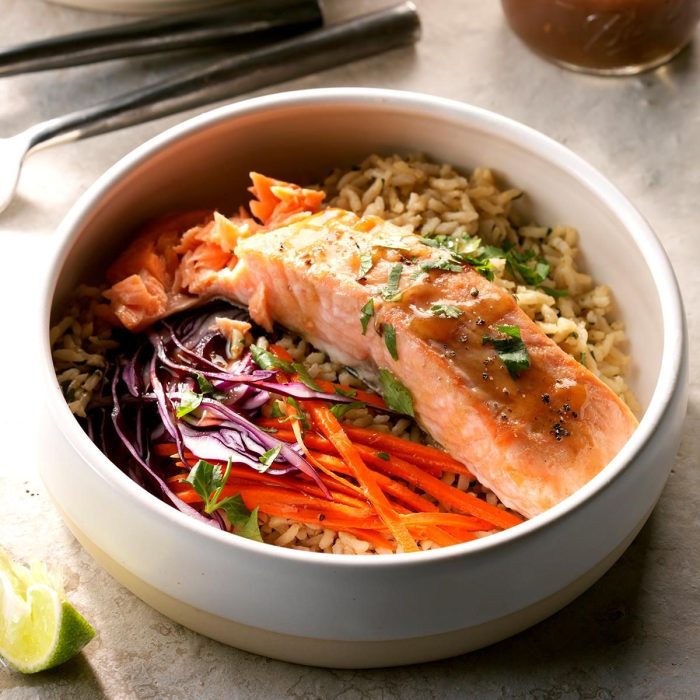
The beauty of salmon and rice lies in its adaptability. This classic combination can be transformed into a myriad of dishes, catering to different tastes and dietary needs. From exploring global interpretations to incorporating alternative protein sources and accommodating dietary restrictions, the possibilities are endless.
Cultural Interpretations
Salmon and rice have long been staples in various cuisines worldwide, resulting in diverse and flavorful dishes.
- Sushi and Sashimi:Japanese cuisine boasts a wide array of salmon-based sushi and sashimi, showcasing the delicate flavor and texture of raw salmon. Nigiri, maki, and sashimi are popular examples, often accompanied by soy sauce, wasabi, and pickled ginger.
- Salmon Poke Bowls:Originating from Hawaii, poke bowls feature diced raw salmon marinated in a variety of sauces, served over a bed of rice with various toppings like avocado, seaweed, and sesame seeds.
Alternative Protein Sources
While salmon is the star ingredient, its role can be easily replaced with other protein sources to create variations.
- Chicken:Chicken, a versatile protein, can be grilled, roasted, or pan-fried and served over rice with a variety of sauces, such as teriyaki or lemon-herb.
- Tofu:For a vegetarian option, tofu can be marinated and pan-fried or baked, offering a hearty and protein-rich alternative to salmon.
- Shrimp:Shrimp, known for its delicate flavor and quick cooking time, pairs well with rice and can be prepared in various ways, including stir-frying, grilling, or steaming.
Dietary Adaptations
Salmon and rice dishes can be easily adapted to accommodate various dietary restrictions.
- Gluten-Free:Choose gluten-free soy sauce and rice varieties like brown rice, quinoa, or wild rice to make the dish gluten-free.
- Vegetarian:Replace salmon with tofu, tempeh, or other plant-based protein sources. Use vegetable broth instead of chicken broth for a vegetarian-friendly sauce.
- Vegan:Choose vegan soy sauce and substitute any animal products with plant-based alternatives, such as vegan butter, coconut milk, and plant-based protein sources.
Serving Suggestions and Presentation
A well-prepared salmon and rice dish deserves a presentation that complements its flavors and textures. The key is to create a visually appealing and harmonious arrangement that highlights the dish’s components while maintaining their optimal temperature and quality.
Serving Temperatures
Serving temperatures play a crucial role in maintaining the quality and flavor of salmon and rice dishes. Salmon should be served warm, ideally at an internal temperature of 145°F (63°C) to ensure it is cooked through while remaining moist and flaky.
Rice, on the other hand, is best served hot, as this allows the grains to retain their texture and release their full flavor.
Plating Arrangements
Plating arrangements for salmon and rice dishes offer a canvas for creativity and visual appeal. Here are some tips for creating elegant and inviting presentations:
- Bowls: Bowls are excellent for serving salmon and rice, especially for casual or family-style meals. Consider using a shallow bowl to create a visually appealing presentation with the salmon and rice arranged side by side or in a circular pattern.
- Plates: Plates provide a more formal setting for serving salmon and rice. Use a dinner plate with a neutral color to allow the dish’s colors to stand out. For a more modern look, consider using a rectangular plate and arranging the salmon and rice in a linear fashion.
- Garnishes: Garnishes add a touch of color, texture, and flavor to salmon and rice dishes. Consider using fresh herbs like dill, parsley, or chives; citrus slices like lemon or lime; or edible flowers for a visually appealing and flavorful garnish.
Food Styling Techniques
Food styling techniques can enhance the overall aesthetic appeal of salmon and rice dishes. Here are some tips for creating visually appealing presentations:
- Color Contrast: Use ingredients with contrasting colors to create a visually appealing presentation. For example, pair the pink salmon with green asparagus and white rice.
- Height and Texture: Create height and texture by layering different ingredients. For example, place a bed of rice on the plate, top it with a piece of salmon, and then add a garnish of fresh herbs.
- Symmetry and Balance: Aim for symmetry and balance in your plating arrangements. This will create a visually pleasing and harmonious presentation.
Recipe Examples
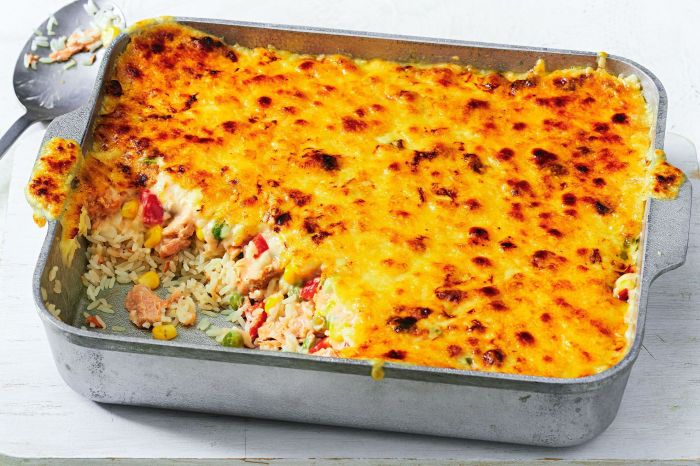
This section showcases two distinct salmon and rice recipes, each offering a unique flavor profile, cooking technique, and side dish combination. These recipes provide inspiration for creating delicious and satisfying meals at home.
Mediterranean Salmon with Lemon-Herb Rice
This recipe features pan-seared salmon with a vibrant Mediterranean flavor profile, complemented by a fragrant lemon-herb rice. The combination of fresh herbs, tangy lemon, and the delicate sweetness of the salmon creates a harmonious and satisfying dish.
Ingredients:
- 1 pound salmon fillet, skin on or off
- 1 tablespoon olive oil
- 1/2 teaspoon salt
- 1/4 teaspoon black pepper
- 1/4 cup chopped fresh parsley
- 1/4 cup chopped fresh dill
- 1/4 cup chopped fresh mint
- 1 cup long-grain rice
- 2 cups chicken broth
- 1/4 cup chopped red onion
- 1/4 cup chopped green bell pepper
- 1/4 cup chopped sun-dried tomatoes
- 1 tablespoon lemon juice
- 1/4 teaspoon dried oregano
- 1/4 teaspoon salt
- 1/8 teaspoon black pepper
Instructions:
- Preheat oven to 400°F (200°C).
- In a small bowl, combine parsley, dill, mint, salt, and pepper.
- Rub the herb mixture onto the salmon fillet.
- Heat olive oil in a large oven-safe skillet over medium heat.
- Sear the salmon for 3-4 minutes per side, or until cooked through.
- Transfer the skillet to the oven and bake for 5-7 minutes.
- While the salmon is baking, prepare the rice. In a medium saucepan, combine rice, chicken broth, red onion, green bell pepper, sun-dried tomatoes, lemon juice, oregano, salt, and pepper.
- Bring to a boil, then reduce heat to low, cover, and simmer for 15-20 minutes, or until the rice is tender and the liquid is absorbed.
- Fluff the rice with a fork and serve immediately with the salmon.
Visual Representation:
The finished dish features a beautifully seared salmon fillet, with a vibrant green herb crust. The rice is fluffy and flavorful, with a medley of colorful vegetables, including red onion, green bell pepper, and sun-dried tomatoes. The overall presentation is bright and inviting, reflecting the Mediterranean flavors of the dish.
The texture is a delightful combination of tender salmon, fluffy rice, and crunchy vegetables. The taste is a harmonious blend of savory, tangy, and slightly sweet notes, with the fresh herbs adding a bright and aromatic touch.
Spicy Salmon with Coconut Rice
This recipe combines the richness of salmon with the exotic flavors of coconut milk and spices. The salmon is marinated in a blend of chili flakes, ginger, and garlic, creating a spicy and aromatic flavor. The coconut rice adds a creamy and subtly sweet element to the dish.
Ingredients:
- 1 pound salmon fillet, skin on or off
- 1 tablespoon olive oil
- 1 tablespoon soy sauce
- 1 tablespoon honey
- 1 teaspoon grated ginger
- 1 clove garlic, minced
- 1/2 teaspoon chili flakes
- 1/4 teaspoon black pepper
- 1 cup long-grain rice
- 1 1/2 cups coconut milk
- 1/4 cup chopped red onion
- 1/4 cup chopped green bell pepper
- 1/4 cup chopped cilantro
- 1/4 teaspoon salt
Instructions:
- In a small bowl, combine olive oil, soy sauce, honey, ginger, garlic, chili flakes, and pepper.
- Marinate the salmon in the mixture for at least 30 minutes, or up to 2 hours.
- Preheat oven to 400°F (200°C).
- Place the marinated salmon on a baking sheet lined with parchment paper.
- Bake for 15-20 minutes, or until cooked through.
- While the salmon is baking, prepare the rice. In a medium saucepan, combine rice, coconut milk, red onion, green bell pepper, cilantro, and salt.
- Bring to a boil, then reduce heat to low, cover, and simmer for 15-20 minutes, or until the rice is tender and the liquid is absorbed.
- Fluff the rice with a fork and serve immediately with the salmon.
Visual Representation:
The finished dish features a succulent salmon fillet, with a beautiful pink color and a slightly crispy exterior. The rice is fluffy and creamy, with a delicate coconut flavor and a hint of spice from the chili flakes. The chopped red onion, green bell pepper, and cilantro add pops of color and freshness to the dish.
The overall presentation is elegant and inviting, with the rich colors and textures of the ingredients creating a visually appealing dish. The texture is a delightful combination of tender salmon, fluffy rice, and crunchy vegetables. The taste is a harmonious blend of spicy, sweet, and savory notes, with the coconut milk adding a creamy and exotic touch.
Final Conclusion: Salmon And Rice Recipe
Whether you’re seeking a simple weeknight dinner or a sophisticated culinary masterpiece, salmon and rice offers endless possibilities. By mastering the fundamentals of salmon preparation, rice cooking, and flavor pairings, you can create a symphony of taste that will delight your palate.
So, embark on this culinary journey and discover the art of crafting the perfect salmon and rice recipe, a dish that will forever hold a special place in your culinary repertoire.
